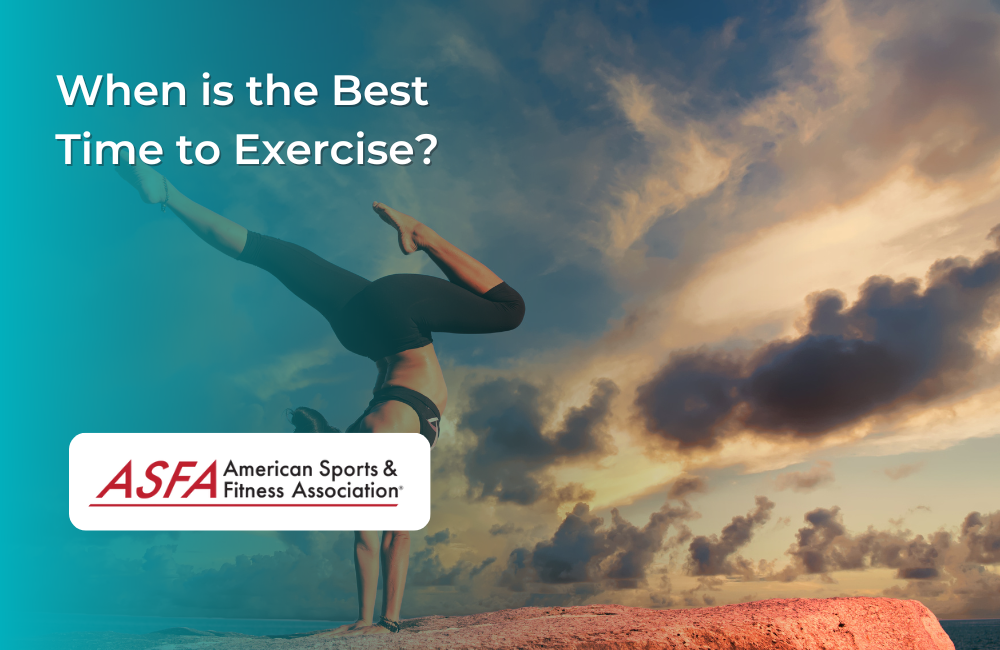When Should You Exercise?
Exercise is an integral part of maintaining a healthy and balanced lifestyle. Regular physical activity has the power to transform both your physical and mental well-being. It reduces the risk of chronic diseases, improves muscle strength, enhances mental clarity, and boosts overall quality of life. Morning exercise can improve focus, energy levels, and overall productivity, while afternoon exercise is particularly beneficial for blood sugar management and improving insulin sensitivity. Whether your goal is to lose weight, build muscle, or simply feel more energized, exercise is key to achieving these outcomes.
By engaging in consistent exercise, you can significantly reduce the risk of serious health conditions, including:
-
Lowered stress levels: Exercise releases endorphins, the body’s natural mood enhancers, which help combat stress and anxiety.
-
Reduced risk of heart disease: Cardiovascular exercises improve heart health, lower cholesterol levels, and help manage blood pressure.
-
Prevention of diabetes: Regular physical activity helps control blood sugar levels, reducing the risk of type 2 diabetes.
-
Improved muscle strength and balance: This is especially important for older adults to maintain mobility, prevent falls, and preserve independence.
Through ASFA, individuals can pursue certifications for personal trainers and coaches. These certifications are designed to help fitness professionals work with various populations, including youth athletes, older adults, and individuals with special needs.
How to Avoid Overexercising: Finding Balance
While exercise is important, overexercising can be harmful to your body and mind. Striking the right balance is essential for making progress without compromising your health. Overexercising can lead to fatigue, injury, and even burnout. Proper exercise timing can help avoid overexercising and improve overall health outcomes. Here are some key strategies to help you avoid overtraining:
Listen to Your Body
Your body provides important signals when it’s time to take a break. If you feel excessively tired or sore after exercising, it may be a sign that you’re pushing too hard. Rest is essential for muscle recovery and overall well-being. Ignoring these signs can lead to injury, weakened performance, and prolonged recovery times. Listening to your body can help maintain optimal exercise performance by ensuring you don't overexert yourself.
2. Create a Balanced Routine
Incorporating a variety of exercises into your workout routine helps prevent overuse injuries. Mixing different types of workouts—such as strength training, cardiovascular exercises, flexibility training, and low-impact activities—ensures that all muscle groups are worked in different ways. This variety prevents muscle imbalances and reduces the risk of repetitive strain injuries.
-
Strength Training: Focuses on building muscle and improving strength.
-
Cardiovascular Training: Boosts heart health and endurance.
-
Flexibility Training: Enhances joint mobility and range of motion.
-
Low-Impact Exercises: Activities like swimming, walking, or yoga, which are gentle on the joints and promote recovery.
Plan Rest Days
Rest days are just as important as workout days. Your muscles need time to repair and grow, and without adequate rest, you risk overtraining. Plan rest days in advance to give your body time to recover while still maintaining a structured routine. This proactive approach also allows you to adjust your schedule without feeling guilty or worried about missing a workout. Additionally, rest days contribute to quality sleep, enhancing overall recovery and ensuring better sleep quality.
Signs of Overexercising: Know When to Take a Step Back
Overexercising can sneak up on you, especially when you’re highly motivated. However, pushing your body beyond its limits can lead to both physical and mental health issues. It’s important to recognize the signs of overtraining early on to prevent long-term harm. Additionally, overexercising can negatively impact sleep quality, making it harder to achieve deeper and more restful sleep.
Persistent Fatigue and Muscle Soreness
Experiencing some muscle soreness is normal after a challenging workout, but constant or severe soreness that lingers for days could indicate overtraining. This could mean you're not giving your muscles enough time to repair, leading to fatigue and decreased performance over time.
Increased Illness, Compromised Immune Function, and Sleep Quality
Overexercising can weaken the immune system, making you more susceptible to illnesses such as colds, flu, and infections. If you find yourself getting sick more often than usual, especially after intense workouts, this could be a sign that your body is stressed and needs more rest. High-intensity workouts without adequate recovery weaken the immune response, leaving the body vulnerable.
Mood Swings and Irritability
Your mental health is just as important as your physical health. Overexercising can lead to mood swings, irritability, and increased feelings of stress or anxiety. If you're feeling emotionally drained or notice negative changes in your mood, it may be time to scale back on your workout intensity or frequency.
Tips for Staying Active Consistently
Staying active is essential, but it’s important to find a fitness routine that you enjoy and can stick to over the long term. Consistency is key to achieving lasting health benefits, and the best way to ensure consistency is by making fitness enjoyable and convenient. Morning workouts and evening workouts can fit different schedules and preferences, allowing you to choose the best time for your body and lifestyle.
1. Choose Activities You Love
If you don't enjoy running, don't force yourself to run. Choose activities that you genuinely enjoy, whether that's hiking, dancing, swimming, or cycling. Finding pleasure in your workouts increases motivation and reduces the chances of quitting. If you enjoy what you're doing, exercise will become something to look forward to rather than a chore.
2. Keep a Workout Journal
Keeping a workout journal or using fitness apps can help you track your progress over time. Tracking your workouts allows you to see your improvements, stay motivated, and adjust your routine as needed. It also helps you identify patterns, such as when you're feeling most energetic or when you might need to take extra rest days.
3. Find Accountability Partners
Having someone to work out with, whether it's a friend, family member, or workout buddy, can make all the difference in staying consistent. Your accountability partner can help motivate you, offer support, and make exercise more enjoyable. Even if you can't work out together in person, checking in with each other through texts or phone calls can help you stay on track.
The Importance of Nutrition in Exercise
Proper nutrition plays a crucial role in how your body performs and recovers after exercise. The right balance of carbohydrates, protein, and fats fuels your workouts, supports muscle repair, and helps maintain your energy levels throughout the day. Without adequate nutrition, your exercise efforts may not yield the results you’re aiming for. Insights from sports medicine emphasize that proper nutrition is essential for optimizing exercise performance and recovery.
1. Pre-Workout Nutrition
Before exercising, it's important to fuel your body with the right nutrients to ensure you have enough energy to perform at your best. Eating a snack rich in carbohydrates provides the necessary fuel, while a small amount of protein helps support muscle function.
Examples of good pre-workout snacks include:
-
Whole grain toast with almond butter
-
Greek yogurt with berries
-
A banana with peanut butter
2. Post-Workout Nutrition
After exercise, your muscles need to recover and rebuild. Consuming a combination of protein and carbohydrates within 30-60 minutes post-workout helps replenish glycogen stores and supports muscle repair. Foods like grilled chicken with quinoa, a protein smoothie, or salmon with brown rice are excellent choices.
3. Essential Nutrients for Recovery
In addition to macronutrients, your body needs a range of vitamins and minerals for optimal muscle function. Key nutrients like iron, calcium, magnesium, and vitamin B6 support energy production, bone health, and muscle recovery. Incorporating nutrient-rich foods like leafy greens, lean meats, nuts, and legumes into your diet ensures your body gets the fuel it needs.
How to Create an Effective Exercise Routine: Exercise Timing
Creating an exercise routine that fits your lifestyle is key to staying consistent and achieving your goals. Whether you’re aiming to lose weight, build strength, or improve your overall health, it’s important to create a plan that’s tailored to your needs. If you are a morning person, designing your routine to include morning workouts can leverage your natural energy levels and potentially offer benefits like lower blood pressure and improved sleep.
1. Set Realistic Goals
Setting achievable fitness goals helps you stay focused and motivated. Whether it’s walking 10,000 steps per day, lifting a certain amount of weight, or running a 5k, having a clear goal in mind gives you a sense of purpose. Morning exercisers can set realistic goals that align with their morning exercise habits, helping them to stay consistent and make the most of their early workouts.
2. Work All Major Muscle Groups
For a balanced routine, aim to work all major muscle groups throughout the week to improve overall exercise performance. This includes exercises for the chest, back, legs, shoulders, and core. Incorporating both upper and lower body exercises ensures your whole body stays strong and functional.
-
Strength Training: Focus on exercises like squats, deadlifts, push-ups, and rows to build strength across your body.
-
Cardio: Incorporate activities like jogging, cycling, or swimming to improve endurance and heart health.
-
Flexibility and Mobility: Include yoga or stretching sessions to improve flexibility and prevent injury.
3. Include Variety and Rest Days
Varying your workouts not only keeps things interesting but also ensures you’re challenging your body in different ways. Combine high-intensity workouts with low-intensity activities and schedule rest days to allow your body time to recover. Rest days prevent burnout and ensure long-term progress. Additionally, scheduling workouts in the early evening can enhance focus and energy levels, provide ample time to unwind after intense sessions, and potentially improve sleep quality.
American Sports & Fitness Association (ASFA) Certification Programs
For those looking to take their passion for fitness to a professional level, the American Sports & Fitness Association (ASFA) offers several certification programs. These programs can help fitness professionals understand the benefits of afternoon workouts, such as lowering blood pressure, managing blood sugar levels, and enhancing exercise performance.
1. Personal Trainer
This teaches individuals how to develop tailored fitness programs for clients based on their personal goals, fitness levels, and health needs. Students learn about exercise science, anatomy, and how to create effective workout plans.
2. Group Fitness Instructor Certification
Designed for individuals who want to lead group fitness classes, this covers the principles of teaching group workouts such as yoga, indoor cycling, or aerobics. It teaches how to motivate and engage participants while ensuring proper form and safety.
3. Youth Sports Coach Certification
This program is ideal for those interested in coaching youth athletes. The teaches effective ways to work with children and teenagers in sports training, focusing on injury prevention, skill development, and fostering a love for physical activity.
Conclusion
Exercise is an essential part of a healthy lifestyle, but balance is key. By listening to your body, planning rest days, and incorporating variety, you can create a sustainable routine that helps you reach your fitness goals without overtraining. Pairing regular exercise with proper nutrition ensures your body is fueled, energized, and ready to recover.
If you’re passionate about fitness and want to help others on their journey to better health, consider exploring certification programs offered by the American Sports & Fitness Association. These programs can equip you with the skills and knowledge needed to guide others toward a healthier lifestyle.
Ultimately, the best exercise routine is one that fits your lifestyle, keeps you motivated, and promotes long-term health. Evening exercise can fit into different lifestyles and promote long-term health by improving workout performance, enhancing aerobic capacity, and facilitating better sleep quality. With the right approach, exercise can become a rewarding and enjoyable part of your daily life.





